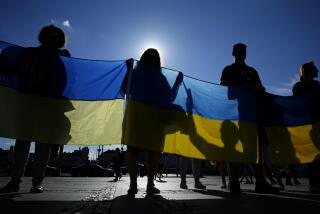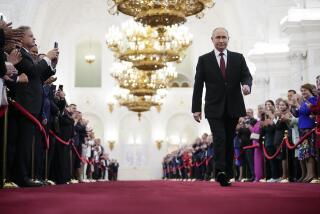Russia museum of democracy more mausoleum
- Share via
Reporting from St. Petersburg, Russia — Bring up the topic of democracy in modern Russia with the director of the Anatoly Sobchak Museum of the Foundation of Democracy in Modern Russia, and she blanches.
“I’m not a connoisseur of politics,” Olga Bozhchenko says apologetically.
And then, “I emphasize the past, not the present. It’s more interesting for me. It’s not that it’s inappropriate. It’s just -- I -- I have nothing to say.”
She is a young woman, dressed all in black, with thick black-framed glasses, a gold cross at her throat and a blond ponytail down her back, presiding over a museum about current events that exists detached from current events.
The museum was created, Bozhchenko says, “to overcome the negative attitudes of society toward democracy.”
“What’s happening now in the country, people don’t like democracy and they connect it to negative things.”
What negative things are those? She stammers for a moment.
“They blame democracy for a lot of things,” she finally says. “They blame it for the lack of correct laws. Now, as for the museum. . . .” And with that, she readjusts her posture and her heels begin to click over the floors once more.
Democracy in Russia: Subject of scholars, dream of reformers, bane of traditionalists. Sought, claimed and tussled over for the last two decades.
And, finally, relegated to a museum.
Buried in the depths of a gloomy palace, wedged alongside offices of state-controlled television, this modest collection of artifacts named with trademark Russian brevity somewhat inadvertently sketches a startlingly keen picture of civic affairs in the great sprawl of Russia.
A trickle of visitors (fewer than two dozen a day) are confronted with a documentary trail of the great shaking-off of communism and the emergence of the little-known men who would grab the country in their hands and fashion, piece by piece, the features of a fledgling democracy.
The walls and display cases groan with newspaper clippings, telegrams and black-and-white snapshots. Campaign posters and speeches. The empty wine bottle from the dark night of some forgotten crisis. Slogans and more slogans.
“Better death than slavery.”
“We don’t need paradise at gunpoint.”
“Let’s hit communism with perestroika.”
On the surface, it’s a museum about Sobchak, the iconic late mayor of St. Petersburg who saw the Soviet Union crumble, helped write Russia’s constitution and ran the country’s second city into the mid-1990s.
But the exhibits are punctuated with glimpses of Vladimir Putin, who has presided at the head of Russian power for a decade. It was Sobchak, after all, who groomed and mentored Putin, and delivered him to the Russian public.
And so it is, in a sense, a democracy museum about Putin, the man whose ascent to power was marked by the loss of a free press, the unsolved killings of political critics and harsh crackdowns on antigovernment protests.
Part of Putin’s mythology is that he is the man who came from nowhere, an obscure KGB officer laboring in the anonymous offices of East Germany; a faceless bureaucrat in the bowels of City Hall.
The pictures here tell a different story. In scene after scene, Putin is there -- never at the center of the action, but hovering on the edges, that unreadable half-smile on his lips, his eyes just visible over somebody’s shoulder. Just some unremarkable guy in a plain suit, standing off to the side and drawing little attention.
There is Putin campaigning for Boris Yeltsin; Putin standing red-eyed and slack-faced at Sobchak’s graveside, clutching red flowers; Putin opening a synagogue.
There are other images: The columns of tanks groaning in defeat from Afghanistan; the throngs of people massed on Palace Square in protest of the Soviet state; the smoke pouring from the Russian White House after it was shelled by tanks during clashes in 1993.
There are tokens of a cracking empire, like the first yellowing newspapers that dared to print stories about Soviet dictator Josef Stalin’s repressions. (Under Putin, Stalin’s reputation has undergone a certain renaissance.)
And there are people. The walls are papered with photos of fiery, hard-driving reformers. By now, they have died, been marginalized or summoned the pragmatism to drop their politics and get rich.
Lawmaker Galina Starovoitova, gunned down outside her apartment building.
Andrei Sakharov, dead.
Yuri Boldyrev, marginalized by today’s Kremlin.
Nikolai Travkin, drifted into obscurity.
Pyotr Aven, one of Russia’s richest bankers, living abroad.
These were the heroes of a revolution. Looking at their pictures, you begin to consider that this is a museum to something that is dead, which is, after all, what usually ends up in a museum.
Sobchak eventually narrowly lost a reelection campaign in 1996 and decamped to France amid a criminal investigation on corruption charges. He stayed overseas until Putin grew more powerful and was greeted by his former protege at the airport upon return; the charges were dropped after Putin became president. (These incidents go unmentioned in the museum.)
Putin repaid his former boss, decreeing the establishment of this museum after Sobchak’s death in 2000. It was inaugurated in 2003 by the man who was then Putin’s chief of staff: President Dmitry Medvedev, another former employee of Sobchak’s who was guided into the Kremlin when term limits forced Putin out of the presidency for a few years.
On the other side of massive windows thrums Nevsky Prospect, the Dostoevsky backdrop that’s been the haunt of every notorious Russian (or Soviet) from Anna Karenina to Stalin.
Today a dismal freezing rain falls over the city; traffic slides over the slushy streets. Russia is rushing on.
More to Read
The biggest entertainment stories
Get our big stories about Hollywood, film, television, music, arts, culture and more right in your inbox as soon as they publish.
You may occasionally receive promotional content from the Los Angeles Times.










